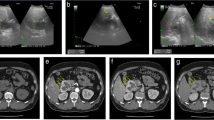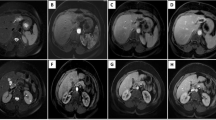Abstract
The radiologic findings of seven patients with sclerosing hepatocellular carcinoma (HCC), an unusual subtype of HCC, were evaluated. Computed tomography (CT) demonstrated a hypointense mass with marked delayed contrast enhancement. Although the tumor was well-defined, the tumor capsule was not seen. Focal atrophy was seen in four patients. Ultrasound (US) showed an isoechoic to hyperechoic mass without a rim. Angiography revealed prominent tumor vessels and prolonged stains in all cases. Arterial encasement was seen in four patients. On magnetic resonance (MR) imaging, all tumors were hypointense on T1-weighted images and hyperintense on T2-weighted images. On dynamic MR study, remarkable contrast enhancement, which continued to the delayed phase, seemed to be characteristic for sclerosing HCC. In the presence of liver tumors with homogeneous architecture, hypervascularity, prolonged enhancement, absence of tumor capsule, and focal atrophy in high-risk patients of HCC, sclerosing HCC should be considered.
Similar content being viewed by others
References
Omata M, Peters R, Tatter D. Sclerosing hepatic carcinoma: relationship to hypercalcemia. Liver 1981;1:33–49
Gibson JB. Histologic typing of tumors of the livers, biliary tract and pancreas. In: International histological classification of tumors, vol. 20. Geneva: World Health Organization, 1978
Kondo Y. Histologic features of hepatocellular carcinoma and allied disorders. Pathol Annu 1985;20:405–430
Craig J, Peters R, Edmondson H, Omata M. Fibrolamellar carcinoma of the liver: a tumor of adolescents and young adults with distinctive clinico-pathologic features. Cancer 1980;46: 372–379
Yoshikawa J, Matsui O, Kadoya Y, Gabata T, Arai K, Takashima T. Delayed enhancement of fibrotic areas in hepatic masses: CT-pathologic correlation. J Comput Assist Tomogr 1992;16:206–211
Yoshida H, Itai Y, Ohtomo K, Kokubo T, Minami M, Yashiro N. Small hepatocellular carcinoma and cavernous hemangioma: differentiation with dynamic FLASH MR imaging with Gd-DTPA. Radiology 1989;171:339–342
Choi BI, Park JH, Kim YI, et al. Peripheral cholangiocarcinoma and clonorchiasis: CT findings. Radiology 1988;169:149–153
Itai Y, Araki T, Furui S, et al. Computed tomography of primary intra-hepatic biliary malignancy. Radiology 1983;147: 485–490
Ros PR, Buck JL, Goodman ZD, Ros AMV, Olmsted WW. Intrahepatic cholangiocarcinoma: radiologic-pathologic correlation. Radiology 1988;167:689–693
Yamashita Y, Takahashi M, Baba Y, et al. Hepatocellular carcinoma with or without cirrhosis: a comparison of CT and angiographic presentations. Abdom Imaging 1993;18:168–175
Author information
Authors and Affiliations
Rights and permissions
About this article
Cite this article
Yamashita, Y., Fan, Z.M., Yamamoto, H. et al. Sclerosing hepatocellular carcinoma: Radiologic findings. Abdom Imaging 18, 347–351 (1993). https://doi.org/10.1007/BF00201779
Received:
Accepted:
Issue Date:
DOI: https://doi.org/10.1007/BF00201779




